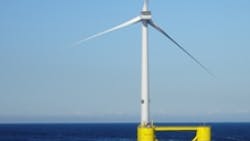Crown Estate issues updates on floating wind leasing plans in Celtic Sea
Offshore staff
LONDON — The Crown Estate has updated developers on the design of the tender process for seabed leasing for floating wind energy in the Celtic Sea. The Celtic Sea program is intended to provide 4 GW of renewable energy capacity by 2035, with the region assessed to have the economic potential to accommodate up to an additional 20 GW by 2045. The program will not only boost the UK’s net-zero ambitions and deliver enhanced energy security but will also create new jobs, skills and investment, including in Wales and the southwest of England.
Today’s update will enable potential developers to form consortia and prepare for the tender, which will launch in mid-2023. The Crown Estate has advised developers that, as part of their participation, they will be expected to provide a plan of their early investment in support of an internationally competitive supply chain. Submission of these plans, alongside other legal, financial and technical elements, will determine whether participants qualify for proceeding to the final stage of the tender.
Developers that are successful in the tender will be expected to update their plans as they develop their projects, so The Crown Estate and other stakeholders can understand how best to support supply chain development.
The final award of an agreement for lease for each site will be based on price offered, meaning greatest value delivered for the nation from the tender process.
Following the announcement in July of five broad "areas of search," The Crown Estate has now published "refined areas of search," which are smaller areas of seabed within which projects may be located in the future. The original areas 1 and 5 have been removed from current consideration, while five smaller areas have been identified within areas 2, 3 and 4, after engagement with multiple stakeholders.
The resulting five smaller areas will be further refined over the coming months into potential project development areas to ensure developers have access to floating offshore wind locations that are expected to be deliverable in the near term. This process will continue to be guided by continued engagement with stakeholders, including fishing communities and environmental groups.
The Crown Estate is seeking to accelerate the leasing process where possible, recognizing the importance of bringing floating wind onstream as soon as possible. The work of identifying project development areas is being undertaken simultaneously with the plan-level Habitats Regulations Assessment, which assesses the potential impact of leasing on environmentally valuable habitats. The Crown Estate will also conduct engineering and environmental surveys in advance of consenting, with a view to being able to supply data to successful bidders to accelerate delivery of their projects, potentially by many months.
10.10.2022
